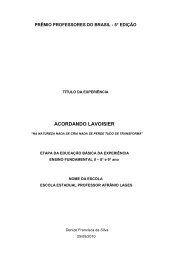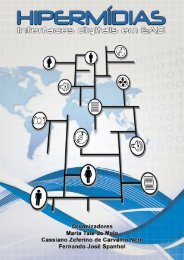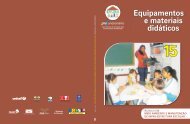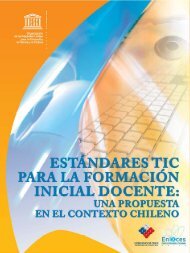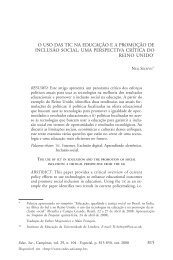BIO-CULTURAL COMMUNITY PROTOCOLS - Portal do Professor
BIO-CULTURAL COMMUNITY PROTOCOLS - Portal do Professor
BIO-CULTURAL COMMUNITY PROTOCOLS - Portal do Professor
Create successful ePaper yourself
Turn your PDF publications into a flip-book with our unique Google optimized e-Paper software.
PART II / CHAPTER 6<br />
5.7 Bio-cultural Checks and Balances Against<br />
Commodification of ESS and Towards<br />
ILCs’ Rights to a Bio-cultural Way of Life<br />
A final fundamental contribution of BCPs to the PES context<br />
lies in its facilitation of ILCs’ expression of their bio-cultural<br />
values and knowledge. BCPs add an additional angle to ESS<br />
through the qualitative valuation of ecosystems’ bio-cultural<br />
resources. In other words, BCPs describe ecosystems in terms<br />
of their bio-cultural rather than their economic value, which<br />
provides a much more holistic assessment of their true value.<br />
Even when bundled, ESS can only be measured in terms of<br />
the values they add to certain economic activities or to a<br />
certain user. Yet, ecosystems that generate economically<br />
valuable ESS <strong>do</strong> so much more than that in terms of the<br />
services they provide to the livelihoods of ILCs, which are rarely,<br />
if ever, measured economically. For example, a forest is not<br />
merely a carbon sink, but also provides ILCs with food,<br />
shelter, medicine, and spiritual guidance, all of which they<br />
have come to depend upon for their livelihoods and biocultural<br />
ways of life. It is for these reasons that ILCs such as<br />
6. Conclusions<br />
While BCPs are not the panacea for making PES work, we<br />
argue that they can be highly supportive in integrating<br />
communities into PES schemes. What may otherwise seem<br />
too complex for possible users of ESS may become feasible<br />
through the BCP process.<br />
BCPs can also serve as a capacity development mechanism<br />
for ILCs that are confronted with the opportunity to enter<br />
into a PES scheme. Participation, capacity development and<br />
increased awareness of what such a scheme entails leads<br />
to empowered communities that are much better prepared<br />
to not only enter into PES negotiations, but also to commit<br />
to the conditions of specific schemes. In addition, basing a<br />
<strong>BIO</strong>-<strong>CULTURAL</strong> <strong>COMMUNITY</strong> <strong>PROTOCOLS</strong> IN THE<br />
CONTEXT OF PAYMENT FOR ECOSYSTEM SERVICES<br />
the pastoralist Raika community described in previous<br />
chapters has not only become dependent on having access<br />
to the land, but has also taken on the stewardship of the<br />
very ecosystem upon which it relies for survival.<br />
During a long history of interaction, the land and the<br />
community have co-evolved a symbiotic relationship in<br />
which they mutually reinforce each other’s<br />
bio-cultural integrity.<br />
Therefore, basing PES schemes on BCPs allows for the<br />
integration of bio-cultural values into a previously economicallyvalued<br />
system and further acknowledges the importance<br />
of bio-cultural values for the preservation of ecosystems<br />
that generate ESS in the first place. Therefore, BCPs generate<br />
a holistic approach to ESS that extends beyond an economic<br />
valuation and includes broader valuation criteria for the<br />
development of a PES scheme. PES schemes may become an<br />
additional mechanism through which ILCs can assert their<br />
rights and gain recognition for the bio-cultural principles<br />
of conservation and sustainable use entrenched in their<br />
traditional ways of life.<br />
PES scheme on a BCP will highlight ILCs’ bio-cultural values<br />
about the ecosystem in question and allow for a more<br />
organic community-based decision-making process than<br />
what typically occurs in a purely economic transaction.<br />
Many other challenges exist, including the need that still<br />
exists for solid scientific and economic analyses to assign<br />
value to ESS. While BCPs will only address some of the<br />
challenges associated with this new and promising PES<br />
scheme, policymakers and entrepreneurs working in this<br />
field should strongly consider integrating them into their<br />
work as they collaborate with ILCs to design and implement<br />
long-term and effective PES schemes well into the future.<br />
66





